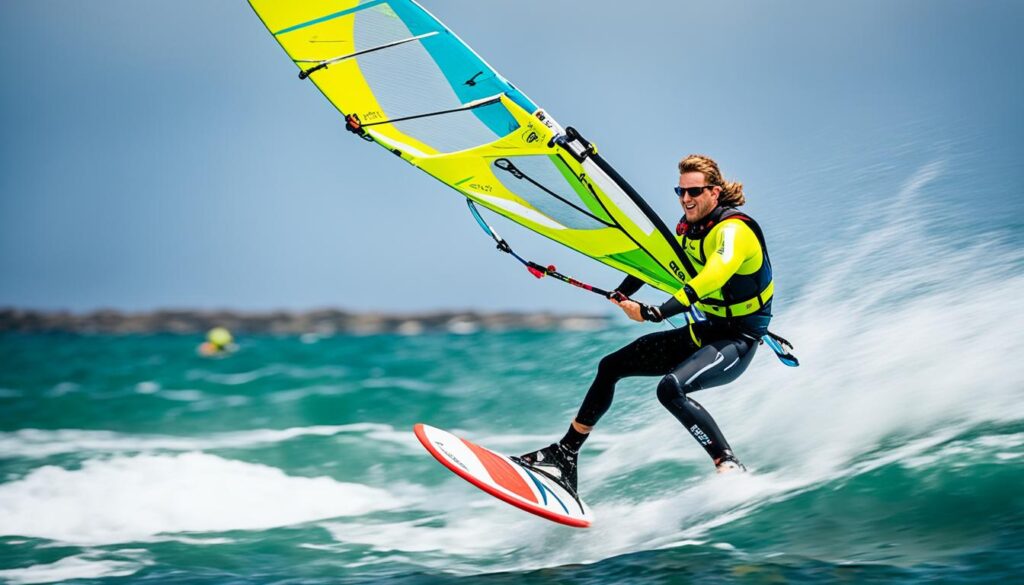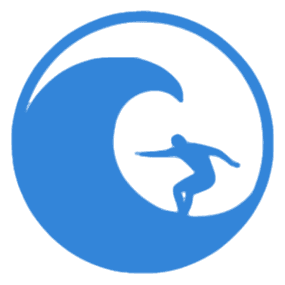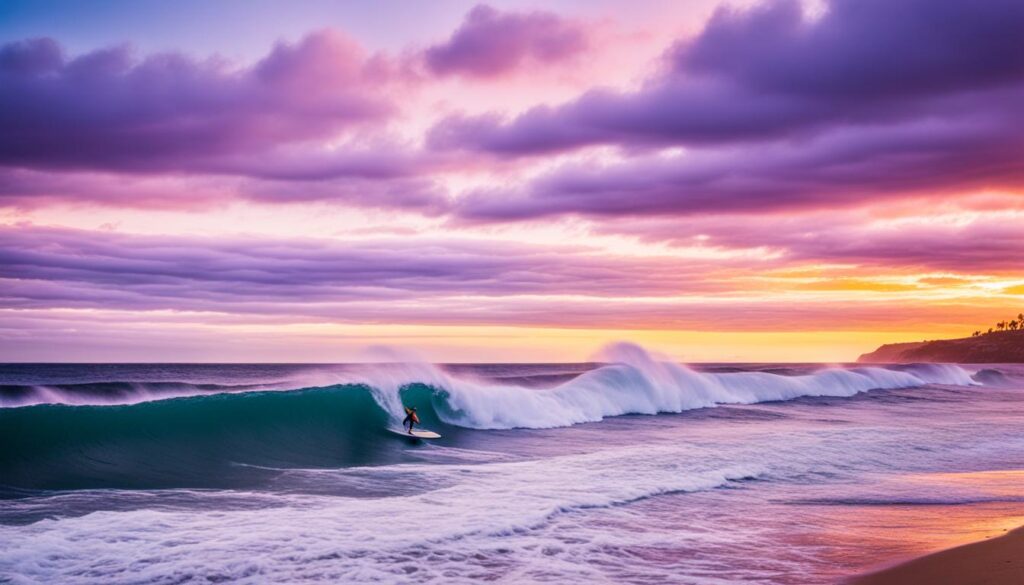Have you ever wondered which ocean sport reigns supreme: surfing or windsurfing? Dive into the world of ocean adventures to discover the exhilarating experiences these sports offer. From riding the waves on a surfboard to harnessing the power of the wind on a windsurfing board, each sport has its own unique charms. So, which one will you choose? Let’s uncover the secrets of surfing and windsurfing and find out which one will have you craving for more.
Key Takeaways:
- Surfing and windsurfing offer thrilling experiences in the world of ocean sports.
- Surfing involves riding waves on a surfboard, while windsurfing combines elements of sailing and surfing.
- Choosing the right equipment is crucial in both these sports.
- Beginners can start with larger boards and smaller sails in windsurfing.
- Advanced surfers can explore maneuvers like carving and aerials.
Surfing and its Allure
Surfing is a sport that has captured the hearts of many adrenaline seekers. It involves riding ocean waves on a surfboard, using body movements and balance to navigate the water. Surfers use different types of surfboards, such as shortboards, longboards, and fishboards, depending on their skill level and preferences. Popular surfing spots around the world include Hawaii’s North Shore, Australia’s Gold Coast, and California’s Huntington Beach.
| Surfboard Type | Size |
|---|---|
| Shortboard | 5’6″ – 7’0″ |
| Longboard | 8’0″ – 11’0″ |
| Fishboard | 5’4″ – 6’8″ |
Surfing Styles
Surfing offers different styles and techniques to suit various wave conditions and rider preferences.
- Shortboard surfing: Designed for high-performance surfing and maneuverability in smaller waves.
- Longboard surfing: Provides stability and glide, ideal for smooth cruising and nose riding.
- Fishboard surfing: Combines characteristics of shortboards and longboards, offering speed and maneuverability in a wider range of wave sizes.
“Surfing is not just a sport; it’s a way of life. The feeling of riding a wave is pure bliss.” – Kelly Slater
Popular Surfing Spots
Surfing enthusiasts flock to popular spots around the world that offer consistent waves and breathtaking scenery.
- Hawaii’s North Shore: Known for its powerful and challenging waves, attracting professional surfers from around the globe.
- Australia’s Gold Coast: Offers a variety of surf breaks suitable for all skill levels, along with a vibrant surf culture.
- California’s Huntington Beach: Known as the “Surf City,” it offers consistent waves and a laid-back surf vibe.
The Thrill of Windsurfing
Windsurfing combines elements of sailing and surfing, creating a thrilling and adventurous water sport that attracts enthusiasts from all over the world. By harnessing the power of the wind, windsurfers are able to glide across the surface of the water and ride the waves with style and grace.
One of the most enticing aspects of windsurfing is the opportunity to explore some of the best windsurfing locations on the planet. From the idyllic beaches of Maui in Hawaii to the windy paradise of Tarifa in Spain, there are countless destinations that offer ideal conditions for windsurfing. Lake Garda in Italy, with its consistent breezes and breathtaking scenery, is another popular spot among windsurfing enthusiasts.
To fully experience the thrill of windsurfing, it’s essential to have the right windsurfing equipment. A typical windsurfing setup includes a windsurfing board, mast, boom, and sail. The board provides stability and buoyancy, allowing the surfer to stand and maneuver on the water. The mast holds the sail upright, while the boom acts as the handlebar for steering and controlling the sail. The sail catches the wind and propels the windsurfer forward, enabling them to ride the waves with exhilaration.
Why Choose Windsurfing?
Windsurfing offers a unique blend of freedom, adrenaline, and connection with nature. It allows you to soar across the water, propelled by the wind, and experience a sense of exhilaration that’s hard to replicate in any other activity.
Unlike traditional surfing, windsurfing gives you the ability to control your speed and direction. With the sail as your wing, you can navigate the water and catch the wind to power your movements. This sense of control, coupled with the dynamics of riding the waves, creates an unmatched sense of joy and accomplishment.
If you’re seeking an adrenaline rush and an opportunity to challenge yourself physically and mentally, windsurfing is the perfect choice. It demands a combination of strength, balance, and skill, pushing you to your limits and rewarding you with moments of pure excitement.
Whether you’re a seasoned windsurfer or a beginner eager to embark on this thrilling adventure, windsurfing offers an unforgettable experience that will leave you craving more.
Choosing the Right Equipment
Selecting the right equipment is crucial for both surfing and windsurfing. The type and size of the equipment play a significant role in determining the overall experience in these water sports.
Surfboard Types and Sizes
Surfers have a wide range of surfboard types to choose from, each designed to perform optimally under specific wave conditions and skill levels. Shortboards, for example, are ideal for high-performance surfing and maneuverability in steep waves. They are usually between 5’6″ to 6’4″ in length and have a narrow, thin profile. On the other hand, longboards offer stability, glide, and ease of catching small waves. They typically range from 8′ to 11′ in length and have a wider, more buoyant shape.
| Surfboard Type | Length (feet) | Best For |
|---|---|---|
| Shortboard | 5’6″ – 6’4″ | High-performance surfing, steep waves |
| Longboard | 8′ – 11′ | Stability, glide, small waves |
Windsurfing Equipment
Windsurfing requires specialized equipment to ride the waves while harnessing the power of the wind. The basic windsurfing setup includes a board, sail, mast, boom, and fin. The size and design of the equipment vary depending on factors like wind strength and rider skill level.
The windsurfing board is typically between 200 to 300 centimeters long, with a volume that provides buoyancy and stability. The mast height may range from 330 to 550 centimeters, offering support and control for the sail. The sail sizes differ based on wind conditions, and the boom length can be adjusted to accommodate different rider heights. Fins are attached to the bottom of the board to improve stability and maneuverability.
| Windsurfing Equipment | Options |
|---|---|
| Board Length (centimeters) | 200 – 300 |
| Mast Height (centimeters) | 330 – 550 |
| Sail Sizes | Varies |
| Boom Length (centimeters) | Adjustable |
| Fins | Attached for stability and maneuverability |
Choosing the right equipment ensures optimal performance and enhances the overall experience in both surfing and windsurfing. It’s important to consider factors like wave conditions, skill level, and personal preferences when selecting surfboards or windsurfing gear.
Beginner Tips for Windsurfing
For beginners venturing into the exciting world of windsurfing, there are a few key tips to keep in mind. Starting with the right windsurfing equipment and taking proper safety precautions are essential for a successful and enjoyable experience.
1. Choose the Right Equipment: To build confidence and develop basic skills, beginners should start with larger, more stable windsurfing boards and smaller sails. These provide better stability and control, making it easier to master the fundamentals.
2. Learn Fundamental Techniques: It’s crucial to learn essential techniques like steering, balancing, and controlling the sail. These skills will form the foundation for more advanced maneuvers and give you better control over the board.
3. Safety First: Safety should be a top priority while learning windsurfing. Always wear a properly fitted wetsuit, helmet, and life jacket to ensure protection in case of any mishaps. Additionally, familiarize yourself with local safety regulations and wind conditions before hitting the water.
4. Take Lessons: Consider taking lessons from a certified instructor. They can provide guidance, teach proper techniques, and ensure you develop good habits right from the start. Lessons can greatly accelerate the learning process and instill confidence in beginners.
5. Practice in Calm Conditions: In the initial stages, choose calm weather conditions with lighter winds to practice and hone your skills. This will help you gain confidence and control before tackling stronger wind and rougher waters.

6. Be Persistent and Patient: Learning windsurfing takes time and effort. Be patient with yourself, embrace the learning process, and celebrate each small victory along the way. Persistence and dedication will pay off as you progress and master more advanced techniques.
“Windsurfing is not just a sport; it’s a way of life. Embrace the thrill, conquer the wind, and ride the waves.”
7. Join a Windsurfing Community: Connect with other windsurfing enthusiasts and join a community of like-minded individuals. They can provide valuable tips, share experiences, and offer support as you embark on your windsurfing journey. Interacting with experienced windsurfers can also help you stay updated on the latest equipment and techniques.
With these beginner tips in mind, you’ll be well on your way to enjoying the exhilarating experience of windsurfing while staying safe and building a solid foundation for your future adventures on the water.
Advanced Techniques in Surfing
As surfers gain experience and hone their skills, they are able to explore advanced surfing techniques that take their wave riding to new heights. These techniques require a combination of skill, balance, and timing, allowing surfers to master even the most challenging waves.
Carving
Carving is a fundamental technique in advanced surfing, where surfers maneuver their board on the face of the wave by applying pressure on the edges. By using their body’s weight and shifting their feet, surfers are able to create smooth, flowing arcs as they ride the wave, maximizing speed and style.
Bottom Turns
Bottom turns are essential for generating speed and setting up for more advanced maneuvers. Surfers execute a powerful turn at the bottom of the wave, using their backhand or front hand to drive the surfboard and redirect their momentum back up the face of the wave, preparing for the next move.
Cutbacks
Cutbacks are stylish and dynamic maneuvers that involve redirecting the board’s trajectory back towards the breaking part of the wave. This allows surfers to maintain their momentum and continue riding the wave, showcasing smooth transitions and control.
Aerials
Aerial maneuvers push the boundaries of surfing, taking the sport to new heights—literally. Surfers launch themselves into the air by utilizing the wave’s energy, using innovative techniques like grabs, rotations, and flips to perform breathtaking tricks above the water’s surface.
Surfers looking to challenge themselves and showcase their skills often seek out renowned surfing spots that offer the perfect combination of wave size, shape, and power. In the quest for the perfect wave, popular surfing spots like Pipeline in Hawaii, Jeffreys Bay in South Africa, and Teahupo’o in Tahiti are known for their challenging and thrilling waves, attracting advanced surfers from around the world.
| Advanced Surfing Techniques | Popular Surfing Spots |
|---|---|
| Carving | Pipeline, Hawaii |
| Bottom Turns | Jeffreys Bay, South Africa |
| Cutbacks | Teahupo’o, Tahiti |
| Aerials |
The Ultimate Ocean Adventures
Whether you choose surfing or windsurfing, both offer thrilling ocean adventures that allow you to connect with nature and ride the waves. Surfers can explore popular spots known for their incredible breaks, while windsurfers seek out destinations with consistent winds and stunning scenery. The choice between these two water sports ultimately depends on personal preference, skill level, and the desire for a specific type of experience.
For surfers, some of the world’s most popular surfing spots beckon with their legendary waves. Hawaii’s North Shore is a pilgrimage for surfers from around the globe, offering powerful and challenging breaks like Pipeline and Sunset Beach. The Gold Coast in Australia is renowned for its consistent waves and vibrant surf culture, attracting professionals and amateurs alike. California’s Huntington Beach, also known as “Surf City,” boasts a lively beach scene and consistently good surf conditions.
On the other hand, windsurfers look for destinations with ideal wind conditions and breathtaking landscapes. Maui in Hawaii is widely regarded as one of the best windsurfing locations, offering steady trade winds and beautiful surroundings. Tarifa in Spain is known as the wind capital of Europe, with its strong and reliable winds attracting windsurfers from all over the world. Italy’s Lake Garda offers a unique experience with its picturesque setting and consistent winds, making it a favorite among windsurfing enthusiasts.
A Comparison of Surfing and Windsurfing Locations
| Surfing | Windsurfing |
|---|---|
| Hawaii’s North Shore | Maui, Hawaii |
| Australia’s Gold Coast | Tarifa, Spain |
| California’s Huntington Beach | Lake Garda, Italy |
Whether you’re drawn to the thrill of riding the waves on a surfboard or harnessing the power of the wind on a windsurfing board, these ocean adventures offer unforgettable experiences. Embark on your chosen water sport and immerse yourself in the beauty of nature, the rush of adrenaline, and the joy of the ocean.
Embracing the Surfing Community
Both surfing and windsurfing create a strong sense of community among participants. Whether you choose surfing or windsurfing, you’ll find yourself surrounded by like-minded individuals who share your love for the water and adventure.
Surfers often gather at popular surfing spots around the world, forming tight-knit communities where they can exchange tips, stories, and camaraderie. It’s not uncommon to see surfers cheering each other on, providing support, and celebrating the thrill of riding the waves together.
Beginners in windsurfing can benefit greatly from being part of this welcoming community. Experienced windsurfers are often eager to share their knowledge and provide guidance to those starting out. They understand the challenges of mastering the sport and are more than willing to offer beginner windsurfing tips and advice to help newcomers navigate the learning curve.
Being part of the surfing and windsurfing community goes beyond enjoying the activities themselves. It creates lasting connections with fellow water enthusiasts who share a common passion. For many, the sense of belonging and the friendships formed within the community are as important as the sport itself.
Contributing to Local Communities
Surfing and windsurfing not only foster a sense of community among participants but also have a positive impact on local communities. Popular surfing spots often become vibrant hubs of tourism, supporting local economies through the influx of visitors and surfing-related businesses.
Surfing and windsurfing can bring people together, making connections that transcend borders and cultures. It’s a beautiful fusion of sport, nature, and human connection.
Surfers and windsurfers also contribute to preserving the environment. Many organizations and individuals in the surfing community actively engage in beach clean-ups and environmental initiatives to protect the oceans and coastal areas they cherish so deeply. By embracing the surfing community, you become part of a collective effort to promote sustainability and preserve the beauty of our natural surroundings.
Conclusion
Surfing and windsurfing are both thrilling and exhilarating ocean adventures that allow you to connect with nature and challenge yourself in unique ways. Whether you prefer the graceful art of surfing or the high-speed excitement of windsurfing, both activities offer opportunities to create lifelong memories and ride the waves to your heart’s content.
Surfing provides a sense of freedom as you navigate the ocean on a surfboard, using your body movements and balance to ride the waves. On the other hand, windsurfing combines the elements of sailing and surfing, allowing you to harness the power of the wind and experience the thrill of gliding on the water.
Whether you choose to surf or windsurf, both sports offer epic ocean adventures that will leave you exhilarated and satisfied. So grab your surfboard or windsurfing equipment, find the perfect beach or windsurfing location, and embrace the excitement and joy of riding the waves. Experience the beauty of the ocean and create memories that will last a lifetime.

